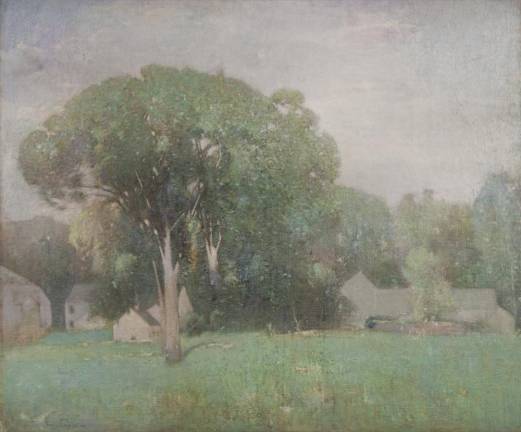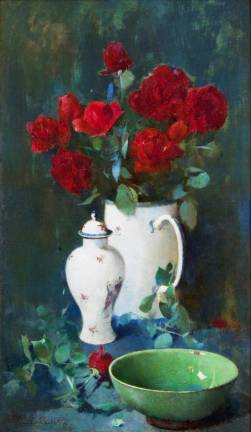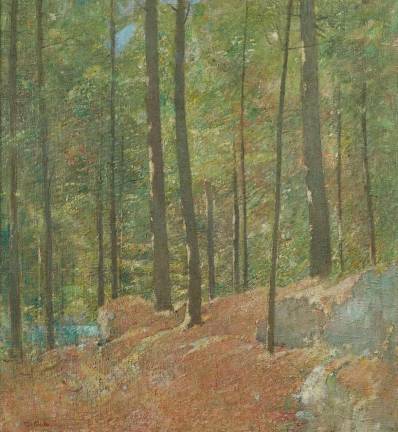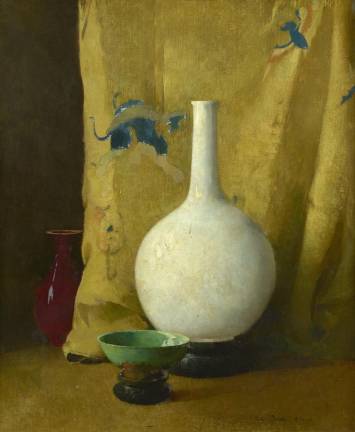Emil Carlsen at the Salmagundi Club
A show of an underappreciated still life artist




The 35 works on display at the Salmagundi Club through September 30 represent the largest collection of works by an underappreciated master of still lifes.
It seems odd that Emil Carlsen would be underappreciated. He was a past member of the Salmagundi and former president of the club. He’s reckoned to be the greatest painter of still lifes of the 20th century, according to William “Bill” Eric Indursky, Director of the Emil Carlsen Archives, curator of the show and Salmagundi executive director.
In any other era, Carlsen would likely be a household name, but he was overshadowed by peers like William Merritt Chase, Julian Alden Weir, and James McNeill Whistler. Another obstacle: most of Carlsen’s works are in private collections. In fact, the scope of this show – the largest collection of his work in 40 years – is only possible with Indursky’s contacts with private collectors in the U.S., gained while he researched his 2017 book, “Emil Carlsen: Conscious Painting.”
Carlsen’s Story
Carlsen, born in Copenhagen, came to Chicago at 19 and eventually became a respected-enough artist to be the first instructor at the Chicago Art Institute. Over the years he traveled widely, toggling between Copenhagen, Paris (where he studied the work of the sublime still life artist Chardin), New York, San Francisco and then back to New York, where he became a member of the National Academy of Design and the Salmagundi Club.
One of the most striking aspects of his work is his fondness for a painting technique called “scraping” – simply scraping the paint off the canvas to reveal the paint below and add texture - and the use of smoky, earthy browns as a base paint for his works. Shadow areas were filled in with thinly dark and then lighter colors. He often used a technique popular at the time called “frosting” – exuberant, thick brushwork of white paint, applied in the end to add more light and drama.
Because of his fondness for scraping, Indursky says, many of Carlsen’s works ultimately had less paint on the canvas than those of his peers. “When he was teaching he would make students who worked on paintings scrape the entire thing off after several hours of labor.” In some works, such as his standout “Afternoon Landscape,” the weave of the canvas is clearly visible and the canvas has a cleaner, lighter, almost airy look.
His Landscapes
The small gallery space near the entrance is a showcase for several small but impactful landscapes that lend themselves to closer inspection. The enchanting “On the Lagoon” is a small but beguiling ode, in color, to Venice. The painting is suffused with soft mist and beautifully subtle color. If it reminds you of one of Whistler’s works, you’d be right; Whistler was an influence on Carlsen at the time. Nearby, by contrast is “Spring Landscape,” a highly finished landscape with touches of subtle greens and a dreamy quality.
These paintings, like all his landscapes in the main room, are delicate, restrained works with a lovely way of handling light reminiscent of other works by Nordic painters. This may be because Carlsen was a painter of landscapes ... in his studio.
How is that possible? A side gallery has the answer in a handful of small works, most not much larger than an 4x6 index card. These miniature landscapes are small color studies, notes for reference for color and form for landscapes. Carlsen took these studies into his studio to “translate them” into his finished works.
One of the “hero” pieces for the show is a landscape of the farm of his close friend, American impressionist Julian Alden Weir. Carlsen considered this work, “Afternoon Landscape,” one of his best. It’s certainly lovely. Placid, clear greens predominate. The leaves on the trees look like delicately executed pointillism; the tree trunks cast into relief by the soft sunlight, the branches dappled by light and shadow. The colors are light and delicate, yet the canvas has substantial amount of texture – so much paint has been scraped off that the texture of the canvas is clearly visible in spots. Carlsen considered this is best landscape and it’s easy to see why.
“Pine Woods,” another pretty and tranquil landscape with a heavily scraped canvas, is bathed with soft light that picks out a few rough textured boulders sitting in soft clay hills. Tucked away in a corner is a clear blue lake. A stand of tall pines are in the foreground but the eye is drawn past them to the riotous mass of shades of green in the leafy background, with touches of white for contrast. You can almost hear the stillness in the forest.
The Still Lifes
Indursky considers Carlsen the best still life artist of the 20th century and the works he selected for this show certainly back up his claim. The panorama of works seems to hearken to other painters’ styles: the quietude and stillness of Chardin, the density and solidity of Corot, the somber color palette of Rembrandt. (Carlsen’s palette is hung, along with other Salmagundi Club members’, in the bar downstairs.) The works fascinate because they seem to combine impressionism with touches of trompe l’oeil and simply gorgeous and dramatic color.
For instance, “Arrangement in Gray” features a gleaming copper sugaring pan, upended, near a bronze milk jug, a grey pot, and a few scattered shallots for a pop of white. The artist used a somber burnt umber as a base paint (the actual pot itself is posed nearby). “He preferred elegant rounded, simple shapes,” Indursky explains, and here the painting seems composed of circles, the sharply defined grey pot balancing the huge sugaring pan. The beautifully defined milk jug reflects both the sugaring pan ... and, if you look closely, the painter’s studio.
The same sugaring pan is the centerpiece of another canvas, “Still Life with Copper Pan.” Here the pan is set on its side, bottom side out, and the frosting of white on its side adds depth and drama. Putting the pan on its side allows the outer surface more play to reflect the small pot placed against it, and the surface it rests on. The small pot, beautifully rendered, also reflects the artist’s studio. The dark bottom on the pan sets off a draped cloth, another pop of white. The play of forms and colors in this work makes it pretty dynamic for a still life. These two works best illustrate Indursky’s observation that “the still lives are very minimal,” Indursky says, “basic shapes drawn in, shaded edges and a little bit of light for drama and emphasis.”
There are many other still lifes here, that demonstrate his skill with reflective surfaces, like “Pewter and Brass” – a simple arrangement of a pewter dish and a copper kettle (and the original kettle is nearby). The kettle shows very clearly a reflection of the four windows in the artist’s studio and the artist himself. “Still Life with Ruffled Grouse” is a somber but beautifully rendered brass pot and a grouse so precisely rendered you can almost count the pinfeathers. It’s the sort of thing Rembrandt might have painted – somber and brooding.
At the far end of the exhibit, near the windows, is the showstopper.
“Roses and Oriental Porcelain” is a painting I would buy if I had $95,000. It’s unreasonably beautiful. The color and gleam of the celadon bowl makes me want to cry; the curve of its rim is perfect. The bowl and two vases are anchored on a greyish surface broken by beautifully painted rose leaves that curl and twine delicately with just a hint of light. The porcelain flowerpot holding the roses, like the bowl, is executed so precisely it could be trompe l’oeil. Amid all this precision, the roses in the vase stand out because of their complete and utter softness. You can feel the velvet of the roses. Their coloring is subtle, the execution is slightly fuzzy and yet Carlsen has managed to capture roses’ very soul. I don’t know who is selling this work and I can’t imagine ever wanting to part with it.
Carlsen is the artist of contradictions. He was Danish by birth but hated the cold. He painted many landscapes and seascapes but was a studio painter. He was an impressionist but many of his still life’s have the precision, even flair, of trompe l’oeil. And he was part of a circle of giants of American impressionism, influenced by them and influencing them – but he never attained the fame of a Chase, a Whistler, or a Weir. This show will correct the record a bit.